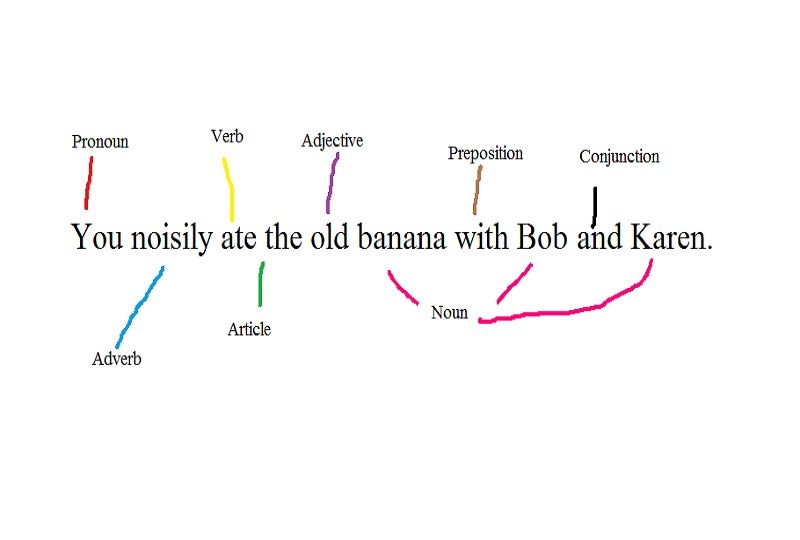How to Learn Italian Verbs and Basic Italian Grammar

Grammar, along with vocabulary, is an important tool in learning a language. Italian grammar is not the most difficult of grammars and learning its rules will help you learn Italian. Below, we have a guide to Italian grammar for beginners—enough grammar to allow you to master the basic points of Italian grammar without being overwhelmed by detail. We will look at Italian verbs in particular, as they are the most important grammar item for beginner Italian learners.

Parts of Speech:
Before learning about Italian grammar, you need to know about the parts of speech, the different types of words that we use. Italian parts of speech are the same as the ones we use in in English.
Here is an example sentence in English to illustrate the different parts of speech:

Nouns: Nouns give a name to a specific thing or group of things (e.g. “banana”, “Bob”, “people”). Names of people and places are a type of noun called proper nouns.
Verbs: A verb is used for actions (e.g. “you ate”, “to run”) or to help describe something (e.g. “I am”).
Adjectives: Adjectives describe nouns (e.g. “old”, “happy”).
Adverbs: Adverbs describe or alter verbs (e.g. “noisily”, “easily”, “well”).
Pronouns: Pronouns can be used to replace nouns. The type of pronouns that you need to know at this point are personal pronouns, i.e. pronouns that correspond to the different grammatical persons (i.e. “I”, “you”, “we”, etc.).
Conjunctions: A conjugation joins two phrases or words with each other (e.g. “and”, “or”, “but”).
Prepositions: A preposition links two nouns, pronouns or phrases with each other (e.g. “with”, “in”, “into”).
Italian Verbs:
Verbs in both English and Italian can change their endings to indicate grammatical person (i.e. “I”, “you”, “we”, “you (pl.)”, “they”) and **tense** (e.g. past, present future).
This is called conjugation. For example, the verb “talk” in English conjugates like:
| Person | Form |
|---|---|
| 1st Person Singular | I talk |
| 2nd Person Singular | you talk |
| 3rd Person Singular | he/she/one talks |
| 1st Person Plural | we talk |
| 2nd Person Plural | you all talk |
| 3rd Person Plural | they talk |
In English, the different persons are indicated by pronouns (i.e. “I”, “you”, etc.) before the verb and not usually by a change in ending. Italian, however, changes for every different person, not just the third person singular (i.e. "she talks" versus "you talk"), and doesn’t need to use pronouns, for example the verb parlare (“to talk”) conjugates like:
Parlare-"to talk"
| Italian | English |
|---|---|
| parl-o | I talk |
| parl-i | you talk |
| parl-a | he/she/one talks |
| parl-iamo | we talk |
| parl-ate | you all talk |
| parl-ano | they talk |
The Three Regular Conjugations:
Most Italian verbs have the same endings, with only the beginning of the verb, the root, changing. There are three different types of Italian verb conjugations, which can be distinguished by their ending in the infinitive, the form of the verb meaning “to do something” (e.g. “to talk”, “to ask”).
The three conjugations are:
- First conjugation: endings in -are (e.g. parlare-“to speak”, amare-“to love”, arrivare-“to arrive”)
- Second conjugation: endings in -ere (e.g. chiedere-“to ask”, prendere-“to take”, mettere-“to put”)
- Third conjugation: endings in-ire (e.g. partire-"to leave", offrire-"to offer")
First Conjugation:
Parlare-to talk
| Italian | English |
|---|---|
| parl-o | I talk |
| parl-i | you talk |
| parl-a | he/she/one talks |
| parl-iamo | we talk |
| parl-ate | you all talk |
| parl-ano | they talk |
Second Conjugation:
Chiedere-to ask
| Italian | English |
|---|---|
| chied-o | I ask |
| chied-i | you ask |
| chied-e | he/she/one asks |
| chied-iamo | we ask |
| chied-ete | you all ask |
| chied-ono | they ask |
Third Conjugation:
Partire-to leave
| Italian | English |
|---|---|
| part-o | I leave |
| part -i | you leave |
| part-e | he/she/one leaves |
| part-iamo | we leave |
| part-ite | you all leave |
| part-ono | they leave |
Third Conjugation in -isc-:
Some -ire verbs add an -isc- onto the stem of all the forms expect for the first person and second person plural (i.e. “we and “you all” forms):
Capire-to understand
| Italian | English |
|---|---|
| cap-isco | I understand |
| cap-isci | you understand |
| cap-isce | he/she/one understands |
| cap-iamo | we understand |
| cap-ite | you all understand |
| cap-iscono | they understand |
As these verbs look the same as other -ire verbs in the infinitive, it pays to learn them off by heart.
Common Endings:
However, all three conjugations are more similar than they are different. For example, the “I”, “you” and “we” forms are exactly the same for all these verbs:
| Italian | English |
|---|---|
| -o | I [verb] |
| -i | you [verb] |
| -a/e | he/she/one [verbs] |
| -iamo | we [verb] |
| -te | you all [verb] |
| -no | they [verb] |
Irregular Verbs:
Italian, like English, has irregular verbs, i.e. verbs that don’t conform to the normal rules about endings. In irregular verbs, the whole word, not just the ending, can change when the verb is conjugated.
Essere and Avere:
The two most important irregular verbs are essere(“to be”) and avere (“to have”). These are vital to know as they are used to form some of the other Italian tenses.
Like “to be” in English, essere is irregular:
Essere-“to be”
| Italian | English |
|---|---|
| sono | I am |
| sei | you are |
| è | he/she/one is |
| siamo | we are |
| siete | you all are |
| sono | they are |
Avere-“to have”
| Italian | English |
|---|---|
| ho | I have |
| hai | you have |
| ha | he/she/one has |
| abbiamo | we have |
| avete | you all have |
| hanno | they have |
Other Irregular Verbs:
Apart from the two main ones, here are some other common irregular verbs you need to know:
Andare-“to go”
| Italian | English |
|---|---|
| vado | I go |
| vi | you go |
| va | he/she/one goes |
| andiamo | we go |
| andate | you all go |
| vanno | they go |
Fare-“to do”, “to make”
| Italian | English |
|---|---|
| faccio | I do |
| fai | you do |
| fa | he/she/one does |
| facciamo | we do |
| fate | you all do |
| fanno | they do |
Potere-“to be able to”, “can”
| Italian | English |
|---|---|
| posso | I can |
| puoi | you can |
| può | he/she/one can |
| possiamo | we can |
| potete | you all can |
| possono | they can |
Dovere-“to have to”
| Italian | English |
|---|---|
| devo | I have to |
| devi | you have to |
| deve | he/she/one has to |
| dobbiamo | we have to |
| dovete | you all have to |
| devono | they have to |
Volere-“to want ”
| Italian | English |
|---|---|
| voglio | I want |
| vuoi | you want |
| vuole | he/she/one wants |
| vogliamo | we want |
| volete | you all want |
| vogliono | they want |
Examples of verbs in a sentence:
Verbs in Italian are used in practically the same way as in English, usually after the subject of the sentence (i.e. the thing doing the verb) and before the object (i.e. the thing that the verb is being done to), for example:
Il treno parte alle otto-“The train leaves at eight”
Mangiamo la pasta-“We are eating pasta”
Compri le scarpe nuove-“You buy new shoes.”
Sono neo-zealandese-“I am a New-Zealander”

Gender
Gender is something that you need to learn before understanding how nouns, adjectives and articles work in Italian. Many English nouns change endings in the plural (e.g. “car” becomes “car-s”, “mouse” becomes “mice”) but Italian nouns, adjectives and articles change endings according to gender as well as number.
Grammatical Gender is where some types of words having different endings according to whether they are “masculine” or “feminine”. English does not have grammatical gender, but there are exceptions (for example, “actor” and “actress”). When talking about people, grammatical gender is based on real life gender (e.g. Marco would be “masculine”), but all nouns in Italian have genders set by custom.
Nouns
Nouns have a fixed gender. For example, pasta is always feminine, whereas biglietto is always masculine.
The masculine gendered ending in Italian is -o in the singular (e.g. biglietto-“ticket”) and -i in the plural (e.g. biglietti-“tickets”).
Biglietto-“ticket”
| Masculine | |
|---|---|
| Singular | bigliett-o |
| Plural | bigliett-i |
| The feminine gendered ending is -a in the singular (e.g. macchina-“car”) and -e in the plural (e.g. macchine-“cars”). |
Macchina-“car”
| Feminine | |
|---|---|
| Singular | macchin-a |
| Plural | macchin-e |
Masculine/Feminine Nouns:
Italian also has nouns that end in -e in the singular and -i in the plural which can be either gender. For example, regione (“region”) is feminine and dottore (“doctor”) is masculine.
Regione-"region”
||Masculine/Feminine|
|-----|-----|-----|
|Singular|region-e|
|Plural|region-i|
There a few rules for the gender of nouns ending in -e:
- Nouns ending in -ione (e.g. regione-“region”, conclusione-"conclusion") are usually feminine.
- Nouns ending in -ore, -ale and -ile are masculine (e.g. dottore-"doctor", giornale-"newspaper").
Nouns without plural forms:
There are some nouns in Italian which don’t have a different ending for the plural (like the English “fish”). However, the plural can be expressed by using the plural definite article.
Two types of these nouns you are likely to see are:
- English loanwords (e.g. sport-“sport”, jogging-“jogging”) which are always masculine.
- Words with an accent on the last letter (e.g. caffé-“coffee”, cittá-“city”) which are always feminine.
For other exceptions in Italian plurals, please see here.

Adjectives
Italian adjectives change their gender and number to match the noun they describe, to "agree" with it (e.g. la macchina bella-“the nice car”; i ragazzi belli-“the handsome boys”). Most adjectives have the same endings as standard masculine and feminine nouns:
Bello-“pretty”, “nice”, “handsome”
| Masculine | Feminine | |
|---|---|---|
| Singular | bell-o | bell-a |
| Plural | bell-i | bell-e |
This means that sometimes the noun and adjective which agrees with it have the same endings (e.g. il ragazzo bello-“the handsome boy”).
However, there are also adjectives ending in -e, which have the same forms for masculine and feminine:
Inglese-“English”
| Masculine/Feminine |
|---|
| Singular | ingles-e |
|---|---|
| Plural | ingles-i |
It is important to be careful when combining nouns and adjectives in -e with nouns and adjectives with the standard endings. For example, it is il ragazzo inglese (“the English boy”) and la ragazza inglese (“the English girl”) instead of il ragazzo ingleso and la ragazza inglesa.

Articles
Italian, like English, has the articles “the” and “a”. In Italian, articles must agree in number and gender with the noun they go with just like adjectives.
Definite articles:
The basic masculine of “the”, the definite article, in Italian is il in the singular and i in the plural. The basic feminine is la in the singular and le in the plural:
| Masculine | Feminine | |
|---|---|---|
| Singular | il | la |
| Plural | i | le |
However, nouns of either gender beginning with a vowel use l’ in the singular (e. g. l’olivo-“the olive”; l’arancia-“the orange”). In the plural, masculine nouns beginning with a vowel take gli (e.g. gli olive-“the olives”). So, the articles for nouns beginning with vowels are:
| Masculine | Feminine | |
|---|---|---|
| Singular | l’ | l’ |
| Plural | gli | le |
Masculine nouns beginning with z, or s-blends (e.g. “sp”, “squ”) use lo in the singular (e.g. lo zaino-“the back-pack”) and, like nouns beginning with a vowel, gli in the plural (e.g. gli zaini-“the back-packs”).
A full summary of the rules would be:
| Masculine | Masculine (beginning with a vowel) | Masculine (beginning with z, gn or s blends) | Feminine | Feminine (beginning with a vowel) | |
|---|---|---|---|---|---|
| Singular | il | l’ | lo | la | l’ |
| Plural | i | gli | gli | le | le |
Indefinite Articles:
“A”, the indefinite article, is usually un in the masculine and una in the feminine:
| Masculine | Feminine |
|---|---|
| un | una |
However, the feminine becomes un’ before a noun beginning with a vowel (e.g. un’arancia-“an orange”) and the masculine becomes uno before a z or s blend (e.g. uno zaino-“a back-pack”).
So, a full summary of the rules would be:
| Masculine | Masculine (beginning with z or s blends) | Feminine | Feminine (beginning with a vowel) |
|---|---|---|---|
| un | uno | una | un’ |
The indefinite article does not have a plural form.
Adverbs
Just as English adverbs usually end in “-ly” (e.g. “usually”, “early”, nearly”), Italian also has a special ending for adverbs: -mente. This is added to the feminine singular of the adjective the adverb comes from, for example:
ovvia-“obvious (feminine)" becomes the adjective ovvia-mente-“obviously”
facile-mente-“easily”
strana-mente-“strangely”
Italian, like English, has irregular adverbs. The most important are:
bene-“well”
male-“badly”
troppo-“too”

Pronouns
Like English pronouns, Italian pronouns have different forms according to their role in the sentence. For example, “I love cats” is said when “I” is the subject of the sentence, but “cats love me” is said if “I” is the object of the sentence. “I” and “me” are respectively called the subject pronoun and the direct (object) pronoun. Italian also has a different pronoun for the indirect object, which is used when a pronoun is preceded by a preposition in English (e.g. “to me”, “for you”).
| Subject Pronoun | Direct Pronoun | Indirect Pronoun |
|---|
| Italian | English | Italian | Italian | Italian | English |
|---|---|---|---|---|---|
| io | I | mi | me | mi | to me |
| tu | you | ti | you | ti | to you |
| lui | he | lo | him/it | gli | to him/it |
| lei | she | la | her | le | to her |
| noi | we | ci | us | ci | to us |
| voi | you all | vi | you all | vi | to you all |
| loro | they | li/le | them | gli | to them |
Direct and indirect pronouns in Italian are a bit difficult for English speakers because they need to be placed before the verb and after the subject (if it is expressed), e.g.
Marco te amo-“Marco loves you”
Lo so-“I know (it)”
The “Lei” form
Italian has a formal form of “you” that can be used in formal situations. This form is not the second person plural form (i.e. "you all") as in French, but the third person singular with feminine pronouns, capitalized to distinguish it (i.e. Lei). Therefore, we have the pronoun forms:
| Subject Pronoun | Direct Pronoun | Indirect Pronoun |
|---|
| Italian | English | Italian | English | Italian | English |
|---|---|---|---|---|---|
| Lei | Sir/Ma’am | La | Sir/Ma’am | Le | to Sir/Ma’am |

Tips for learning Italian verbs and grammar
Italian grammar is not too difficult to pick up. However, you might need some tools and resources to help you along the way:
Verbs:
- A time-honoured way of learning verbs is to repeat all the forms over and over aloud or by writing them out again and again.
- You may be able to find songs on Youtube specifically made to help learn verbs (e.g. this one), though there aren’t as many as for French. Some existing songs, however, contain helpful examples of different verb forms.
Grammar in general:
- Talking in Italian is a great way to practise Italian grammar.
- Listening to Italian songs. Speechling has an article with some good examples of songs to listen to.
- Doing fill in the blank grammar exercises:
a. Workbooks such as Italian Verb Drills or Practice Makes Perfect: Italian Pronouns and Prepositions are very good.
b. For exercises on all aspects of Italian Grammar, I would highly recommend Gramm.it for English Speakers.
c. Try Speechling’s Free Language Quizzes and Free Fill in the Blank Exercises to help you practise using Italian grammar in context.
